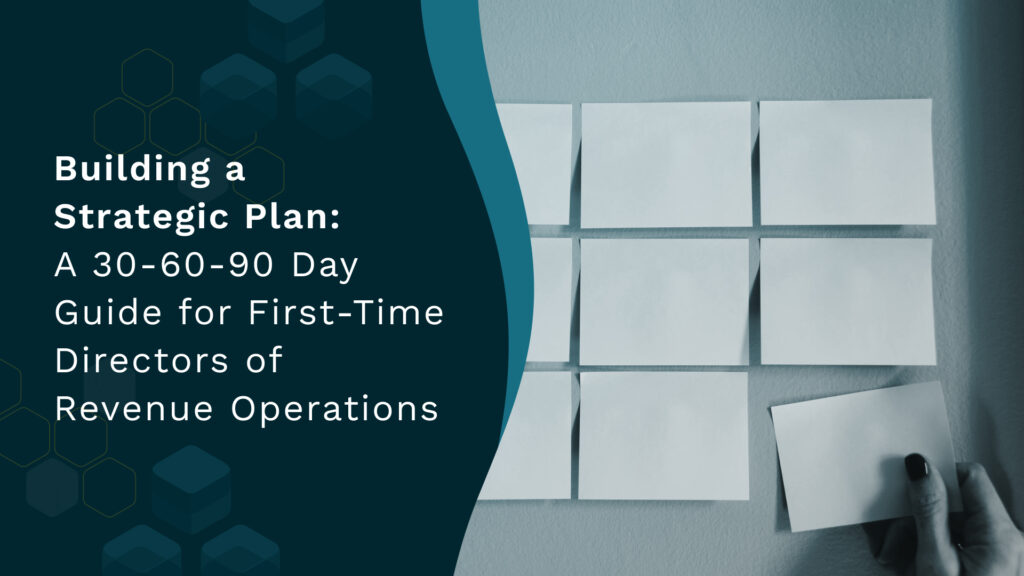
Everything You Need To Know About Revenue Enablement
Meet Revenue Enablement, the key to lasting customer relationships and seamless engagement. Here's an ultimate guide.
An evolving buyer journey is prompting the rise of self-serve solutions. As much as 81% of buyers want more self-serve options from sellers. Additionally, 72% of buyers also want a rep-free experience.
Buyers know they can find more information on solutions through digital channels. When they do contact a seller, they already have enough details about the product.
While sales enablement uses resources to educate the buyer, the seller’s role today involves more than that. It’s about nurturing buyers towards conversion throughout the buying journey, even if they’re not the ones directly in touch with the lead.
The customer’s journey has transitioned into fast selling, something that is more sophisticated. You need to put more effort into not just how you manage your sale, but also how you manage the relationship.
Leore spira, head of revops at buildots
But several B2B organizations lack end-to-end customer engagement with no clear ownership of the entire experience. To achieve that, you must drive a concerted effort with customer-facing teams using “revenue enablement.”
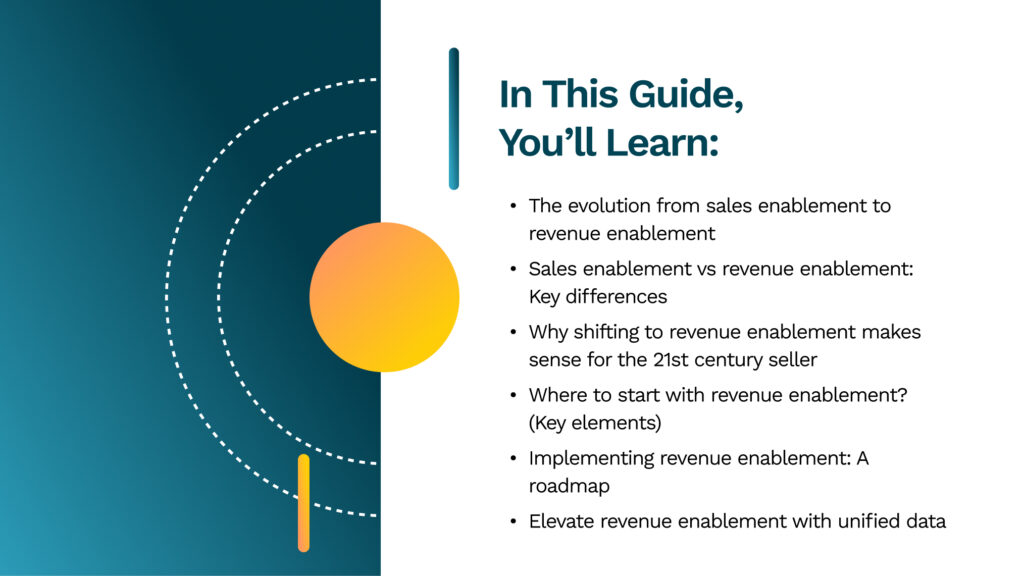
Evolving From Sales Enablement to Revenue Enablement
Revenue enablement attracts and retains customers for your business, maximizing revenue at each stage of the buyer journey by delivering exceptional customer experience.
It’s an enhanced version of the sales enablement concept. Here’s how:
- Revenue enablement expands the initial scope to support all revenue-generating buyer touchpoints instead of just enabling the sales team.
- For today’s digital-first buyers, it simplifies virtual and hybrid selling environments through end-to-end alignment between revenue-generating teams. This creates a more seamless buying experience.
- It consolidates KPIs and metrics for all customer-facing functions. It also uses data and analytics from the entire buyer journey across the tech stack.
The result? A strong foundation for enablement by supporting the complete customer lifecycle.
We need to look at the customer journey as a holistic journey. Because then you can manage the relationship and customer conversations, and support sales to make sure that we convert prospects into customers faster than we did before.
leore spira, head of revops at buildots
78% of revenue teams already see benefits with enablement tech helping them provide superior customer experience.
But does that make it better than sales enablement? Let’s find out by comparing sales enablement vs revenue enablement.
Sales Enablement vs Revenue Enablement: Key Differences
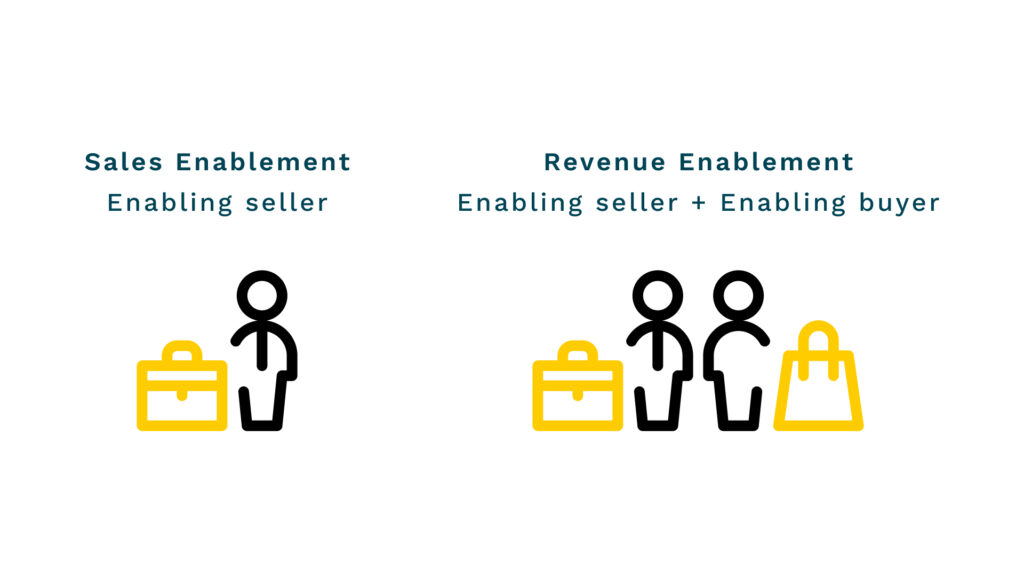
Both processes begin with the same goals:
- To shorten the length of the sales cycle, and
- To hit higher win rates.
But that’s where the similarities end. Revenue enablement broadens the scope of sales enablement into different capabilities.
Here’s how sales enablement vs revenue enablement stacks up:
1. Broader Scope
While sales enablement primarily deals with sales, revenue enablement covers more revenue sources. These include cross-sells, upsells, renewals, and referrals, across all customer touchpoints.
2. Focus
Sales enablement is more about enabling the seller. Revenue enablement focuses on helping the customer instead through a frictionless journey. It places the customer at the center of all business decisions.
3. Stage
Sales starts engaging with leads once they’ve been qualified by marketing. Also, the function aims to get leads to the next stage, i.e., conversion.
However, revenue enablement interacts with audiences even before they become prospects. It continues engaging with customers in the later phases of the buying journey.
4. Metrics
Sales enablement focuses on sales-led metrics such as deal closure rate, time-to-close, and the like.
Revenue enablement looks at the larger picture with more customer-focused metrics like LTV, retention, and renewal rates.
5. Training
Unlike sales enablement, which is all about the sales team, revenue enablement ensures that all revenue-generating teams are trained. These include presales, marketing, SDRs, BDRs, inside sales, channel managers, channel partners, and customer success.
6. Collaborative Approach
With sales enablement, reps may not work closely with other teams (mainly marketing and customer success), creating silos.
Revenue enablement aims to break down these silos with shared goals, common incentives, standard processes, and cross-functional alignment.

Why Shifting to Revenue Enablement Makes Sense for the 21st-Century Seller
Even though “sales enablement” is popular, enablement doesn’t just occur in sales. All parts of a sales organization have systems, tools, processes, and KPIs to encourage enablement.
The more we hold onto the ‘sales enablement’ term, the longer our horizons are seen as limited to focusing only on sales training. Enablement is about the entire buyer journey and supporting our GTM leaders to fill gaps in customer-facing people, processes, and technologies.
Matt Cohen, senior enablement manager, Dotmatics
But this creates silos between different functions, fostering a disconnected customer experience. It becomes even more apparent when there are multiple buyer touchpoints present.
Disjointed communication among customer-facing teams becomes a barrier to business growth.
Here’s how revenue enablement plays out in a simplified and connected buying journey.
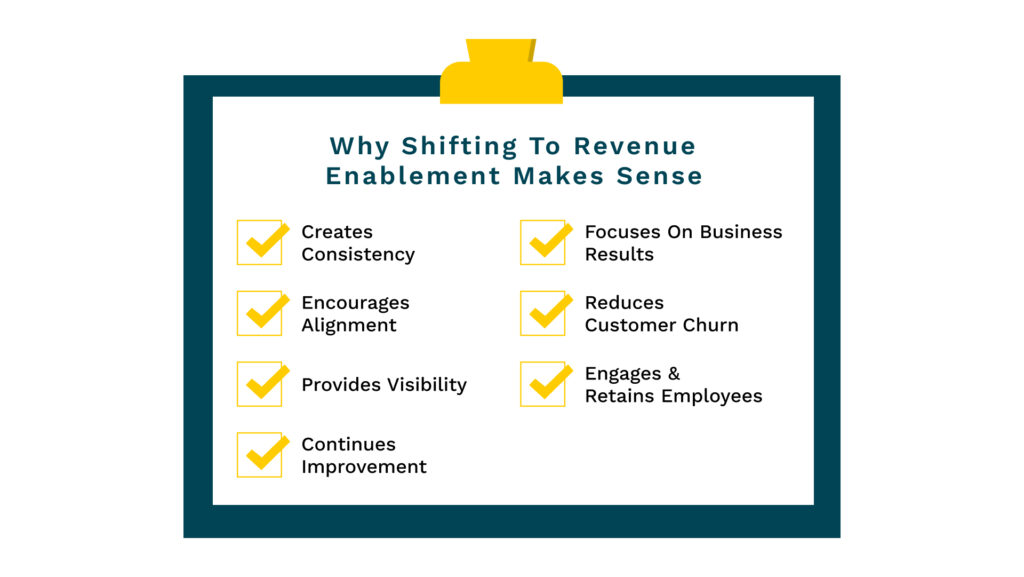
✔ Creates Consistency
All revenue functions use consistent messaging backed by a unified tech stack, unified data, and similar sales motions. Everyone speaks the same language and offers the same value proposition.
✔ Encourages Alignment
With revenue enablement, all teams work together to improve revenue generation. Integrating content, training, and coaching resources reduces friction and disjointed handoffs.
✔ Provides Visibility
All customer-facing teams have complete visibility over the prospect’s journey through the sales funnel. This makes it easier to optimize enablement at different stages of a deal.
✔ Continues Improvement
Since revenue enablement is highly process-centric, it ensures that changes are adopted, documented, and analyzed regularly. Managers can then review errors and bottlenecks to be fixed.
✔ Focuses on Business Results
Enablement focuses on business goals and outcomes throughout the revenue generation process. It improves individual processes for a holistic impact on customer experience and revenue.
✔ Reduces Customer Churn
By providing customers with an overall better buying experience, you can increase your LTV. Today, 58% of buyers are willing to pay more for better customer service.
✔ Engages and Retains Employees
Revenue enablement makes it easier to establish common financial objectives and incentives for customer-facing teams. This also ensures that employees have a better experience with your organization and stay longer.
Yes, revenue enablement comes with all the bells and whistles. But how can you start implementing it?
Where to Start With Revenue Enablement? (Key Elements)

We’ve condensed the technical information from Gartner’s map into 5 key elements.
1. Data
With revenue-generating activities going virtual or hybrid, teams need efficient digital tools to get complete visibility into accounts. This visibility is powered by clean data that’s not stuck in siloed systems.
Oftentimes where silos happen is people creating new data fields and different systems. Nobody really knows what data to trust for making key business decisions.
Dan Jiao, Sr. Director RevOps, Signifyd
Clean and contextual data is the starting point of all RevOps and revenue enablement activities. It’s critical for maintaining transparency, understanding revenue growth, and making critical business decisions.
2. Tech Stack
As your business grows, you need technology to map the buyer touch points across the revenue funnel. Having the right tech helps you find gaps in the funnel, take stock of them, and plug them.
You must eliminate legacy or unused tech. Instead, invest in integrated and AI-powered enabled tools for real-time visibility.
3. Content
Content is a vital part of sales enablement. Carry this into revenue enablement by making content easily and centrally accessible to all functions. You could also hold weekly or monthly meetings to discuss and review content assets at the RevOps level.
4. Talent
Talent is all about understanding your teams’ skills and addressing gaps in customer experience. It starts with checking if you have the right talent in the right role. And if you don’t, you must train the reps to improve their capabilities.
Align teams on common KPIs, objectives, workflows, and messaging so they all speak the same language and learn from each other.
5. Process
It’s critical only to include processes that generate results. If you end up with processes that were developed in a vacuum, without consideration for overall business goals, let go of them. They’re a waste of resources and revenue.
Alternatively, construct processes for each team to contribute to the revenue engine.
Once you have your critical elements, it’s time to start implementing your revenue enablement plan.
Implementing Revenue Enablement: A Roadmap
Over two-thirds of sales enablement leaders already embrace revenue enablement, seeing an improved commercial performance.
You need to set up a strategic plan to break down silos and support continuous growth. We’ve charted out a 7-step roadmap that you can follow to implement revenue enablement.
Step 1: Find Gaps in the Current Customer Experience Process
Evaluate your current customer experience and lay down the future state you want to achieve. Start by understanding how these two scenarios will impact your revenue growth.
Compare them and weasel out any gaps or friction points. You can find these gaps by asking yourself some of the below questions:
- What could we be doing better?
- What is the current churn rate, and when does it go up?
- In which areas should teams collaborate more?
- What are the gaps costing us in revenue?
- What are some things we can replicate from the current state?
For example, the inability to keep up with digital transformation in the current state can be a deterrent. The gap could be resistance to change and a lack of automation or AI capabilities. It’s substantial enough to warrant a different action plan in your revenue enablement roadmap.
Finding and listing gaps ensures you don’t miss critical changes.
Step 2: Design a Migration Plan
The second step involves designing a migration plan from sales to revenue enablement. The plan must revolve around the customer journey and touchpoints, with a strong focus on your business goals.
Map the customer journey from discovery to onboarding and ongoing support to determine the key touch points you should target.
Design the revenue process down to the T by figuring out the following:
- When does marketing hand over a lead?
- When does SDR get involved?
- When does the AE step in?
- When is the customer handed off to customer success?
Align the revenue process with documentation—playbooks, call scripts, content resources—to provide the right experience at the right time during the customer journey.
And there you have it. Your migration plan is ready. But the implementation process is far from over.
Step 3: Structure Your Teams
To structure your teams for the shift to revenue enablement, find out:
- Who are the critical revenue-enabling stakeholders in each team?
- Which teams need additional support or resources, and in which areas?
- What do successfully enabled teams look like?
Teams that you should look at are pre-sales, AEs or enterprise sellers, inside sales, SDRs, BDRs, channel partners, customer success, marketing, and product.
Map these roles as well as their teams and processes to the customer journey. This keeps all revenue teams aligned to provide a consistent customer experience, meet digital engagement expectations, reduce friction during handoffs, and improve overall decision-making.
Being able to align the teams under shared KPIs is fantastic. (You’re) telling everybody what’s in it for them. And then, the tactical piece is setting up standing meetings with the entire team, talking through what they did on that day or week to drive towards the shared KPIs. It’s just getting the leaders in the room every day to see that their counterparts are working towards the same goal. It sounds really simple, but it is hugely impactful.
Eric Welsh, Director of RevOps, Demostack
Structuring your teams also reduces selling complexity. You can provide all teams with consistent coaching and integrated tools to manage content and real-time guidance.
In case you need additional resources, create an onboarding strategy for new hires, particularly if their role needs them to be at the center of cross-functional activities. An onboarding strategy tells new hires everything they need to know about your revenue enablement plan and how they can contribute from the get-go.
Step 4: Encourage a Culture Shift
Customer-facing teams must develop the perspective that they’re all “sellers” even if they’re not in sales. Their end goal is to deliver exceptional customer experience consistently.
All teams work together by turning opportunities into leads and, finally, into customers. Along the way, they must maintain customer relationships, improve retention, encourage advocacy, and increase upsells.
Hitting these objectives takes a work culture fueled by teamwork, collaboration, and mutual understanding across all organizational roles.
And it starts right at the top with leadership. Get executive buy-in for your revenue enablement strategy before implementing it. Show your key stakeholders data and solid numbers that represent the gaps and how you can fill them.
Next, get employee buy-in by encouraging teams to step out of their comfort zones, embrace change and develop consensus with other teams.
Step 5: Embed the Process
After getting executive and employee buy-in, you can implement the revenue enablement process. But just implementation isn’t enough. You need to embed the process within your organization.
Do this by helping your teams develop their knowledge and skills with playbooks and coaching plans. Equipping the team with everything they need to imbibe the process reinforces revenue-enabling behaviors for the long term.
Start with
- Knowledge training: It helps with fundamental understanding. Knowledge includes content or resources for your solutions, such as features, benefits, messaging, and use cases.
Follow it up with
- Skills training: This has more to do with developing soft skills. These soft skills include coaching reps on answering impact questions, building a storytelling approach to selling, handling objections, qualifying leads, and more.
Next, comes
- Playbooks: Playbooks outline the steps each role can take when interacting with buyers and presenting your value proposition.
Finally, round up the process with
- Coaching: Coaching includes continued adaptive training and upskilling. You could even offer specialized certifications for different roles based on different customer lifecycle stages.
Remember, the above activities aren’t just for reps. Include your managers in embedding the revenue process, too.
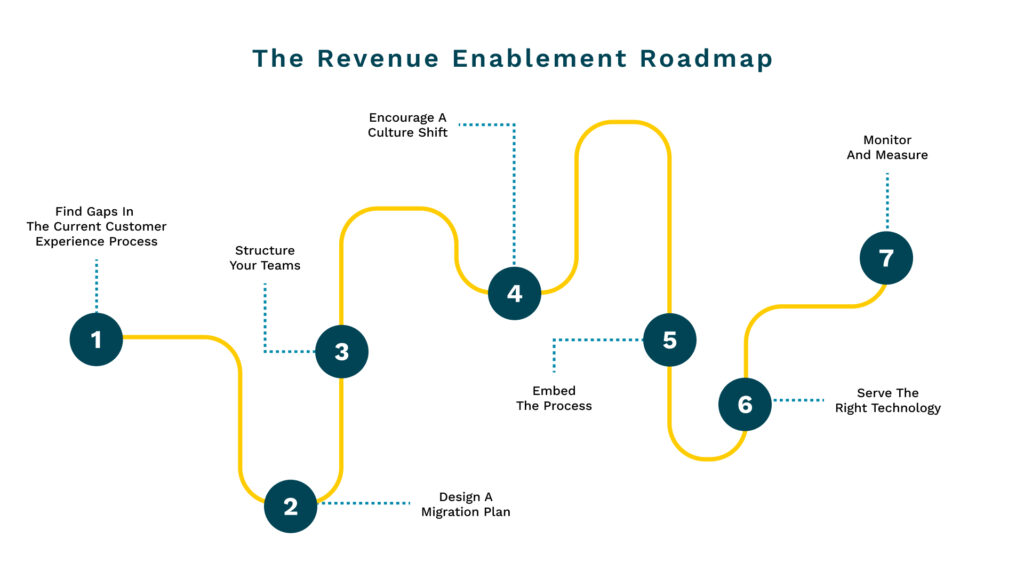
Step 6: Serve the Right Technology
Having the right technology is central to your revenue enablement strategy. To begin with, audit your existing tech stack and cross-reference it with your customer journey.
This will help you figure out:
- Which processes must be automated?
- What do the current tools offer?
- How can a revenue enablement tool improve your tech stack?
- What vital integrations do you need?
- What additional functionalities do you need?
The tech stack you build must provide end-to-end customer journey data to the teams. CRM is generally at the center of all revenue activities, so empower it to become the single source of truth.
You need to centralize contact data, content resources, and training and coaching resources. Alongside this, your tech stack should provide a constant feedback loop to improve customer interactions continuously.
Using automation, improve your tech stack to make it scalable and efficient.
Step 7: Monitor and Measure
Metrics are the guiding blocks to measure your progress with revenue enablement. Use them to monitor analytics and insights, identifying where you can make strategic improvements and tactical optimization.
Since multiple functions are involved, shared goals, KPIs, and metrics make it easier to measure performance and tie back to individual teams.
Some of the key metrics you must track across the buyer journey are:
- Win-loss rate
- Average deal size
- Average contract value
- Net new revenue
- Average sales cycle
- Customer churn
- Revenue churn
- Customer satisfaction scores (CSAT)
- Customer acquisition cost (CAC)
- Customer lifetime value
Your revenue enablement plan is now ready for implementation and optimization. But wait, there’s one last thing to do.
Elevate Revenue Enablement With Unified Data
Consistent communication and seamless buyer interactions need clean data.
Each team uses a fragmented tech stack that builds siloed data when working on individual enablement processes. As revenue enablement brings teams together, creating a solid foundation with clean data is critical.
It also saves teams from getting locked up in cognitive overload by having to look for information in multiple tools.
Nektar simplifies the unification of data from multiple channels and customer touchpoints. Your teams get complete access to relevant account and contact data across the tech stack. Nektar also simplifies integration with several tools and connects revenue enablement tools to the CRM.
Take your CRM to the next level by making it the single source of truth and power revenue enablement with clean, unified data. Reach out to our team to find out how you can embed Nektar in your revops process.
PUBLISHED BY
